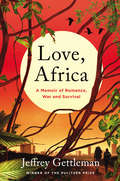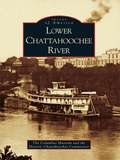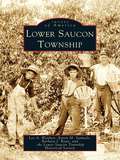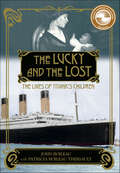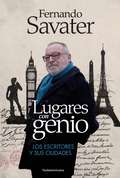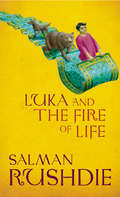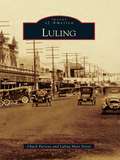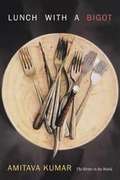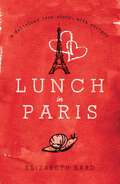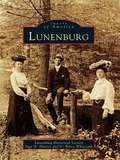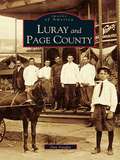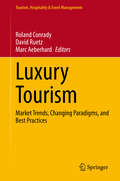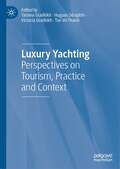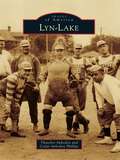- Table View
- List View
Love, Africa: A Memoir of Romance, War, and Survival
by Jeffrey Gettleman“A page-turner. The portrait of Africa that emerges is disturbing, tender, and harsh. . . . A tremendous read. I couldn’t put it down.” —Abraham Verghese, New York Times–bestselling author of The Covenant of WaterA seasoned war correspondent, Jeffrey Gettleman has covered every major conflict over the past twenty years, from Afghanistan to Iraq to the Congo. For the past decade, he has served as the East Africa bureau chief for the New York Times, fulfilling a teenage dream.At nineteen, Gettleman fell in love, twice. On a do-it-yourself community service trip in college, he went to East Africa—a terrifying, exciting, dreamlike part of the world in the throes of change that imprinted itself on his imagination and on his heart.But around that same time he also fell in love with a fellow Cornell student—the brightest, classiest, most principled woman he’d ever met. To say they were opposites was an understatement. She became a criminal lawyer in America; he hungered to return to Africa. For the next decade he would be torn between these two abiding passions.A sensually rendered coming-of-age story, Love, Africa is a tale of passion, violence, far-flung adventure, tortuous long-distance relationships, screwing up, forgiveness, parenthood, and happiness that explores the power of finding yourself in the most unexpected of places. “Aptly displays why [Gettleman's] a Pulitzer Prize winner and a New York Times bureau chief . . . there's a thrilling immediacy and attention to detail in Gettleman's writing that puts the reader right beside him. . . . An absolute must-read.” —Booklist, starred review“Love, Africa offers a key to understanding humankind’s past and future and a key to understanding our hearts.” —Sheryl Sandberg
Low Mountains or High Tea: Misadventures in Britain's National Parks
by Steve SiebersonWhen Steve Sieberson and his wife unexpectedly found themselves in Britain with an entire summer on their hands, they readily agreed to avoid the usual tourist attractions, opting instead for a road trip to the UK’s far-flung national parks. As they set out, however, he envisioned bracing days of energetic hillwalking, while she assumed they would relax in tearooms and cozy pubs. Seldom planning more than a few days in advance, the two traversed the country in a rented Vauxhall, subjecting themselves to single-track lanes, diabolical signage, and whimsical advice from locals. They discovered a town called Mirthless, a place where cats’ eyes are removed, and a vibrating cottage, while at mealtimes they dove fearlessly into black pudding, Eton mess, and barely recognizable enchiladas. Meanwhile, after their initial attempts at hiking together nearly ended in disaster, Sieberson received dispensation to scramble alone to the highest point in each national park—as long as he was quick about it and left plenty of time for more sedentary pursuits. Low Mountains or High Tea dishes up the charms and eccentricities of rural Great Britain as seen through the eyes of two Americans who never really knew what was coming next.
Lowell
by Lisa Barker Plank Lowell Area Historical MuseumSettlement of the Lowell area centered on the confluence of the Grand and Flat Rivers. Joseph and Magdaleine LaFramboise first established a fur trading post near the Ottawa village, Segwun, where the rivers meet. The community grew as settlers poured into the area attracted by the growing lumber industry and rich farmland. Diverse businesses emerged including a cutter factory, a vibrant clamming industry, and the state's oldest family-run flour mill. A unique feature of the area is Fallasburg Historic Village. Once an active mill town on the Flat River, Fallasburg slid into obscurity when the railroad passed it by. At the height of the Great Depression, businessmen of Lowell joined together to build a showboat to draw visitors to town. The Lowell Showboat is now one of the most recognizable attractions in Lowell. This book explores both well known and more obscure aspects of Lowell's history through a wealth of images, many never published before.
Lower Brazos River Canals
by Lora-Marie BernardCommunities have spent more than 100 years mastering the mighty Brazos River and its waterways. In the 1800s, Stephen F. Austin chose the Brazos River as the site for the first Texas colony because of its vast water and fertile soil. Within 75 years, a pumping station would herald the way for crop management. A sugar mill that was eventually known as Imperial Sugar spurred community development. In 1903, John Miles Frost Jr. tapped the Brazos to expand the Cane and Rice Belt Irrigation System while Houston newspapers predicted the infrastructure marvel would change the region's future--and it did. Within a few decades, the Texas agricultural empire caused Louisiana to dub Texas farmers "the sugar and rice aristocracy." As the dawn of the industrial age began, the Brazos River and its waterways began supplying the Texas Gulf Coast industry.
Lower Chattahoochee River
by The Columbus Museum Historic Chattahoochee CommissionThe Chattahoochee River has dramatically shaped the heritage of the lower Chattahoochee Valley of east and southeast Alabama and west and southwest Georgia. As the region's dominant geographic feature, the Chattahoochee has served residents of the area as an engine for commerce and as an important transportation route for centuries. It has also been a natural and recreational resource, as well as an inspiration for creativity. From the stream's role as one of the South's busiest trade routes to the dynamic array of water-powered industry it made possible, the river has been at the very center of the forces that have shaped the unique character of the area. A vital part of the community's past, present, and future, it binds the Chattahoochee Valley together as a distinctive region. Through a variety of images, including historic photographs, postcards, and artwork, this book illustrates the importance of the Chattahoochee River to the region it has helped sustain.
Lower Saucon Township (Images of America)
by Karen M. Samuels Lee A. Weidner Barbara J. Ryan Lower Saucon Township Historical SocietyLower Saucon Township provides a unique glimpse of the region's many diverse villages and the German immigrant population. Towns including Wassergass, Shimersville, Polk Valley, Redington, and Bingen were settled largely because of the area's fertile soil, abundant water, and many iron and limestone deposits, which contributed to surrounding communities such as Bethlehem and Hellertown both socially and economically. These rare family photographs depict a blend of lives that influenced the area before and after the industrial revolution.
Lowndes County (Images of America)
by Lowndes County Historical Society Dr Joseph TomberlinLowndes County, located deep in the wiregrass region of southern Georgia, has been continuously occupied since ancient times. Through the centuries, various Native American tribes inhabited the region, but they lingered relatively briefly and left few tangible traces. The area's written history began with the establishment around 1623 of the Spanish mission of Santa Cruz de Cachipile in southern Lowndes. Georgia's general assembly created Lowndes County from the southern half of Irwin County in 1825 and named it for William Jones Lowndes of South Carolina. The present county seat, Valdosta, dates from the construction of the Atlantic and Gulf Railroad across Lowndes from 1859 to 1860. Ultimately the county was to have five railroads, which, combined with U.S. Highways 41 and 84 and Interstate 75, were to be major factors in dramatic local growth."
Lowville
by Charlotte M. Beagle Dorothy K. DufloLowville, first settled in 1796, is part of the Black River valley, an area laden with fertile land and rich forests. The town continued to develop through the years, supporting hotels, flour mills and gristmills, furniture manufacturers, cheese plants, tanneries, and even a brewery. Lowville's place in history was sealed when, by 1878, it was producing eight million pounds of cheese annually with a value at that time of $1 million. The earlier manufacturing businesses gradually faded, and Lowville ushered in the 20th century as an important dairy center, a tradition that continues to this day.
Lucky and the Lost: The Lives of Titanic’s Children
by John BoileauMore than half the children aboard Titanic died in the sinking, calling into question the notion of “women and children first.” In The Lucky and the Lost: The Lives of Titanic’s Children, historian John Boileau tells the stories of the children who fortunately escaped in lifeboats and those who tragically did not. It also examines the heart-breaking circumstances of the victims’ deaths as well as the fascinating stories of survivors’ lives. Uniquely, The Lucky and the Lost tells the stories of ten yet-unborn children whose mothers survived to give birth. This includes the children of Madeleine Astor, wife of John Jacob Astor—the richest man to perish in the disaster—and Juliette Laroche, wife of Joseph Laroche, the only Black man onboard, as well as the stories of twenty-three Lebanese children onboard, another largely unknown feature of the disaster. The Lucky and the Lost includes compelling stories of survivors in later life (an aspect not included in most Titanic books) and the lasting effect the sinking had on them. With forty black-and-white images as well as numerous maps and illustrations, The Lucky and the Lost offers the most complete accounting to date of the fates of the children aboard the doomed ocean liner.
Ludlow (Images of America)
by Karen E. PilonIncorporated on February 28, 1774, Ludlow, Massachusetts, was originally a part of Springfield. The origin of the name remains a mystery, though the most probable explanation is that it was named afterRoger Ludlow, an early prominent New England citizen who played a great part in building up the town and taking care of its citizens. The Ludlow Manufacturing Company, formed around 1900 by Charles T. Hubbard, helped shape the town by providing housing, a library, schools, playgrounds, and even a clubhouse for the diverse community. Ludlow was home to many sawmills and gristmills, utilizing the power from the several sources of water nearby, including the Chicopee River, Broad Brook, Higher Brook, and Stony Brook. The town is most noted, however, for its factory mills and production of jute yarns, twine, and webbing. Less well known was the glass-making business that was prevalent in the early 1800s. John Sikes manufactured glass bottles andother glassware and the Ludlow Manufacturing Company glass works operated for only a short time before closing in the depression years following the War of 1812. Today, Ludlow remains a culturally diversecommunity made up of Portuguese, Polish, French, and Irish residents, just to name a few.
Lugares con genio: Los escritores y sus ciudades
by Fernando SavaterDos placeres: literatura y viajes. Cómo las ciudades influenciaron lavida y la obra de autores como Virginia Woolf, Octavio Paz, Jorge LuisBorges, Franz Kafka, entre otros. Este maravilloso libro conjuga las dos grandes pasiones de FernandoSavater: la literatura y los viajes. Recorriendo las principalesciudades del mundo, Savater nos lleva de la mano por los lugares quefrecuentaron los grandes escritores. Mezcla de diario de viaje ybiografía, en este libro nos encontramos con el profundo lazo queune a un autor con su ciudad de origen: Londres y Virginia Woolf, Méxicoy Octavio Paz, Santiago de Chile y Pablo Neruda, Buenos Aires y JorgeLuis Borges, Praga y Franz Kafka, Lisboa y Fernando Pessoa, Florencia yDante Alighieri, Edimburgo y Stevenson, Gran Bretaña y Chateaubriand,entre otros.Con su sello personal -siempre recreativo y ameno, lejos de lasolemnidad del homenaje-, conocemos los sitios emblemáticos de cadaautor, rastreamos los vestigios de su paso y el ímpetu de la ciudadsobre su obra.Savater se sumerge en la idiosincrasia de cada ciudad; explora su vidacotidiana, su gastronomía y sus hitos, buscando la influencia queejerció cada lugar en la vida de los autores.«Lugares con genio» descubre esos rincones célebres y secretos, quesirvieron de escenario o inspiración para la gran literatura mundial.
Luka and the Fire of Life
by Salman RushdieOn a beautiful starry night in the city of Kahani in the land of Alifbay a terrible thing happened: twelve-year-old Luka's storyteller father, Rashid, fell suddenly and inexplicably into a sleep so deep that nothing and no one could rouse him. To save him from slipping away entirely, Luka must embark on a journey through the Magic World, encountering a slew of phantasmagorical obstacles along the way, to steal the Fire of Life, a seemingly impossible and exceedingly dangerous task. With Haroun and the Sea of Stories Salman Rushdie proved that he is one of the best contemporary writers of fables, and it proved to be one of his most popular books with readers of all ages. While Haroun was written as a gift for his first son, Luka and the Fire of Life, the story of Haroun's younger brother, is a gift for his second son on his twelfth birthday. Lyrical, rich with word-play, and with the narrative tension of the classic quest stories, this is Salman Rushdie at his very best.
Luling (Images of America)
by Luling Main StreetOne historian described Luling in the 1870s as "the toughest town in Texas." Along with the railroad came notorious gamblers who were ready to take a man's hard-earned money any way they could. But when settlers enforced what laws there were and established permanent homes, churches, and a school, the rougher crowd sought greener pastures. In the southern corner of Caldwell County, Luling had at first an agrarian-based economy, but that changed with the discovery of oil, which boosted the population from a few hundred residents to several thousand. The oil industry and related businesses kept the population steady. Luling soil also proved beneficial to crops such as cotton, but the area's prize crop became watermelons. Today oil and watermelons keep Luling on the map, and the annual Watermelon Thump attracts thousands. At the crossroads of three important highways, businesses flourish, especially barbecue, which is considered by some to be the best in the state.
Lumen
by Ben PastorEqual parts wartime political intrigue, detective story, psychological thriller and religious mystery, Pastor's debut follows a German army captain and a Chicago priest as they investigate the death of a nun in Nazi-occupied Poland. Stunned by the violence of the occupation and by the ideology of his colleagues, Bora's sense of Prussian duty is tested to the breaking point.
Lunch With a Bigot: The Writer in the World
by Amitava KumarTo be a writer, Amitava Kumar says, is to be an observer. The twenty-six essays in Lunch with a Bigot are Kumar's observations of the world put into words. A mix of memoir, reportage, and criticism, the essays include encounters with writers Salman Rushdie and Arundhati Roy, discussions on the craft of writing, and a portrait of the struggles of a Bollywood actor. The title essay is Kumar's account of his visit to a member of an ultra-right Hindu organization who put him on a hit-list. In these and other essays, Kumar tells a broader story of immigration, change, and a shift to a more globalized existence, all the while demonstrating how he practices being a writer in the world.
Lunch in Paris: A Delicious Love Story, with Recipes
by Elizabeth BardPart love story, part cookbook, Lunch in Paris is a forthright and funny story of falling in love with a Frenchman and moving to the world’s most romantic city. From gutting her first fish to discovering the French version of Death by Chocolate, Elizabeth finds that learning to cook and building a new life have a lot in common.
Lunch in Paris: A Love Story, with Recipes
by Elizabeth BardIn Paris for a weekend visit, Elizabeth Bard sat down to lunch with a handsome Frenchman--and never went home again. Was it love at first sight? Or was it the way her knife slid effortlessly through her pavé au poivre, the steak's pink juices puddling into the buttery pepper sauce? LUNCH IN PARIS is a memoir about a young American woman caught up in two passionate love affairs--one with her new beau, Gwendal, the other with French cuisine. Packing her bags for a new life in the world's most romantic city, Elizabeth is plunged into a world of bustling open-air markets, hipster bistros, and size 2 femmes fatales. She learns to gut her first fish (with a little help from Jane Austen), soothe pangs of homesickness (with the rise of a chocolate soufflé) and develops a crush on her local butcher (who bears a striking resemblance to Matt Dillon). Elizabeth finds that the deeper she immerses herself in the world of French cuisine, the more Paris itself begins to translate. French culture, she discovers, is not unlike a well-ripened cheese-there may be a crusty exterior, until you cut through to the melting, piquant heart. Peppered with mouth-watering recipes for summer ratatouille, swordfish tartare and molten chocolate cakes, Lunch in Paris is a story of falling in love, redefining success and discovering what it truly means to be at home. In the delicious tradition of memoirs like A Year in Provence and Under the Tuscan Sun, this book is the perfect treat for anyone who has dreamed that lunch in Paris could change their life.
Lunenburg
by Inge H. Hunter Lunenburg Historical Society G. Barry WhitcombThe name "Luneburg" was coined for King George II of England, who was also the duke of Luneburg, Germany, in 1727. The final name, Lunenburg, was probably a result of misspelling in the early records of the town. On August 1, 1728, Lunenburg was officially granted township but, as early as 1726, a variety of industries had been started and twenty-six houses had been built. In the late nineteenth century, the town returned to predominately agriculture and, today, is a rural residential community for industries in neighboring cities. Through a diverse collection of vintage images, Lunenburg will take you on a historical journey through the town's engaging past. Within these pages, you will see photographs of the early businesses that were established, such as bookbinders, blacksmiths, furniture makers, and shoe manufacturers; you will visit many homes, churches, schools and government buildings; and you will experience the daily lives of residents during this exciting time in history.
Luray and Page County (Images of America)
by Dan VaughnFormed out of necessity in 1831, Page County had a great need to operate within its own boundaries of the Massanutten and Blue Ridge Mountains. A very unique situation arose when this rural area was coupled with the discovery in 1878 of something as spectacular as the Luray Caverns. Along with this new fame followed a large influx of tourists, industry, and varied commerce into the entire county from the lifeline created by the formation of the Shenandoah Valley Railroad in 1881. During the reconstruction years after the Civil War, and with the formation of "land and improvement" companies throughout the United States, Page County, along with the rest of the country, was booming. In fact, this unbridled growth was happening much too fast for this newly reformed country. This in turn brought about a severe recession in the 1890s that affected everyone, including the people of Page, no matter how secure they may have seemed with their new attraction. The culmination of these events initiated a quaint photographic history that is contained within the pages of Images of America: Luray and Page County.
Luray and Page County Revisited
by Dan VaughnLuray Caverns, discovered in the quiet valley community of Luray in 1878, became the main attraction in Page County. In hopes of capitalizing on this new found "Wonder of the World," executives of the Shenandoah Valley Railroad completed the rail from Hagerstown and Basic City to Luray by 1881. Mann Almond drove the final ceremonial spike just north of Deford's Tannery in Luray. With the arrival of the railroad came a new economy supported by passengers, excursionists, lodging, and freight transport. The bulk of these transports were Eureka Mining Company's mineral extractions and Shenandoah's "BigGem" iron bloom shipments. Luray's own "Mercantile Mile" leading to the caverns was laden with storehouses, offering goods found in larger cities, and the rail brought visitors in droves. The photographers who produced the images contained here did so only as a means of income, but today their work is our visual link to the past.
Lutherans in Western New York
by Julianna Fiddler-Woite Rev Jamie RetallackDuring the construction of the Erie Canal in the early 1820s, the population of Western New York increased 145 percent. Many of these pioneers were European immigrants, with a high concentration hailing from the German-speaking states. These immigrants brought their Lutheran ideals and continued to practice the religion in their new homeland. By 1827, the first official Lutheran church in Erie County had been incorporated as the German Reformed Church, known today as St. Paul's Lutheran Church in Eggertsville. Soon after, the need for mission churches arose, and by the mid-1800s, Lutheran congregations had been established in several Western New York suburbs. During the following century, the Lutherans in Western New York would undergo growth and change. While all congregations eventually abandoned German as their primary language, many struggled to further separate from their German roots during the Nazi regime. Today, there are nearly 200 Lutheran congregations in New York.
Luxury Tourism: Market Trends, Changing Paradigms, and Best Practices (Tourism, Hospitality & Event Management)
by Roland Conrady David Ruetz Marc AeberhardOver the past two decades, through unprecedented levels of prosperity and changing values, luxury tourism has transformed into a new consumption pattern. This book analyzes the topic in detail with contributions from both recognized scientists and prominent executives in the luxury business. It shows how the concept of luxury has shifted from material to immaterial dimensions, and outlines new trends that will shape the luxury market in the future. The content includes carefully selected leading examples from the most important segments of the tourism market, along with concrete recommendations and best practices. Sharing unique insights, the book is a must-read for those working in the tourism industry, as well as lecturers and university students of tourism.
Luxury Yachting: Perspectives on Tourism, Practice and Context
by Tatiana Gladkikh Hugues Séraphin Victoria Gladkikh Tan Vo-ThanhThis book offers an insight into the luxury yacht industry as a provider and facilitator of a luxury yacht experience. Linked to special interest tourism (SIT), luxury yachting is an exclusive area of tourism and practice which operates in a relatively small and niche environment. Part I offers a range of academic contributions on luxury yachting from a tourism perspective. Part II provides an insight into the industry from the practitioner perspective. Part III stimulates discussions around yachting practices in different destinations. With a truly global outlook, this contributed volume enhances our understanding of a lucrative area within tourism that has so far been under-researched and under-explored.
Luz de luna: Cuatro volcanes de México
by Jorge M. MierEscalar los volcanes de México me ha obligado a cambiar la mirada, a observarlo todo bajo otra luz, mientras caminaba con ellos en la oscuridad. Luz de luna es la crónica de una aventura. Jorge M. Mier, inspirado por su profesor, el conocido cronista y articulista Martín Caparrós, salió en busca de historias y encontró algo que contar. <P><P>Se trata de un trabajo literario que retoma las enseñanzas de los grandes escritores del «nuevo periodismo» americano y que coloca a su autor en el centro de los hechos. Escribiendo sobre su escalada en los volcanes más altos de México, Mier nos acerca al alpinismo en el país, dando voz a unos personajes que se dibujan solos y que, en su lucha por ser profesionales de este deporte, muestran sus virtudes y sus carencias, sus inquietudes y sus miedos y, sobre todo, su gran valor humano. <P><P>En esa aventura se descubren también unos volcanes llenos de misticismo, con nombres que nacen de mitos y leyendas de las culturas que dominaron el continente antes de la llegada de los españoles.
Lyn-Lake (Images of America)
by Thatcher Imboden Cedar Imboden PhillipsThe Lyn-Lake area of Minneapolis, centered around the intersection of Lyndale Avenue and West Lake Street, is one of the city's most distinctive neighborhoods. The core commercial district is one of the oldest in South Minneapolis, thanks in part to its strategic location along several early streetcar lines. A rail line along Twenty-ninth Street, now the Midtown Greenway, brought an industrial element to the neighborhood and provided additional jobs for the thousands of residents who lived in the surrounding houses and apartment buildings. As the neighborhood evolved, it took on a distinctive bohemian bent and filled with a diverse mix of artists, musicians, and writers living side by side with blue-collar industrial workers, along with those who worked at professional office jobs downtown. Lyn-Lake retains its unique flavor today, characterized by its blend of both the historical and the cutting edge.
